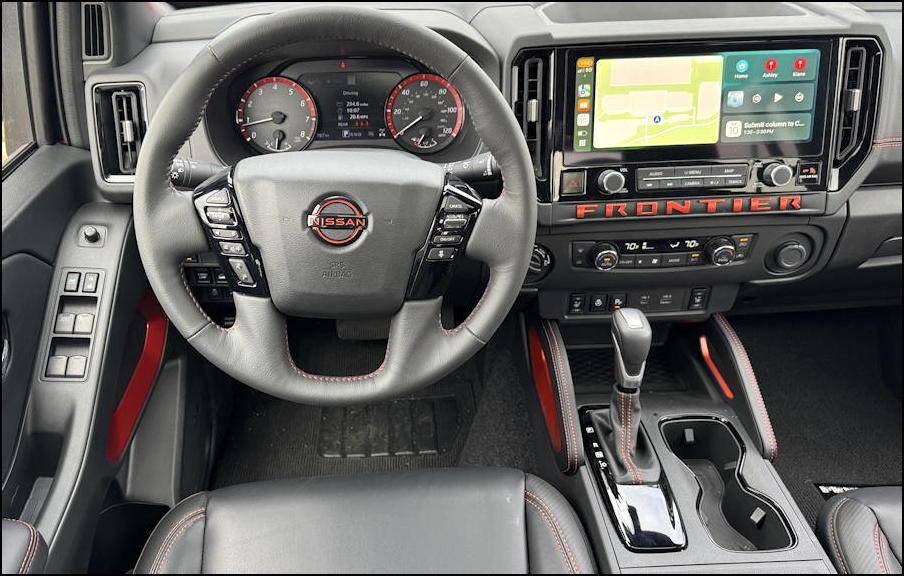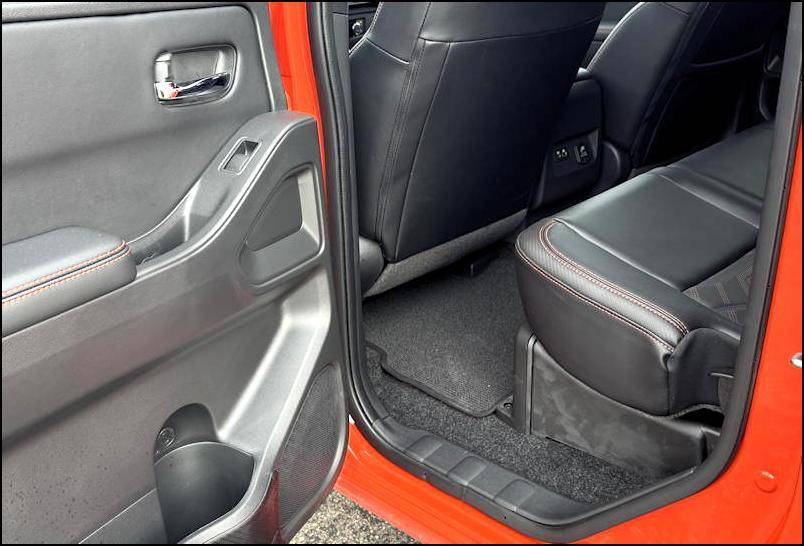Pickup trucks seem to be getting bigger and bigger, and there sure seem to be plenty of 3/4-ton and bigger trucks squeezed into too-small parking spots in every lot. Most owners, however, don't haul much cargo, making it hard to figure out why they'd want one of these beasts in their driveway.
Enter the midsize pickup truck. With a typical truck bed of 6-feet (or shorter), they typically offer seating for 4-5 people inside the "crew" cab and sufficient bed capacity for a run to the garden store, some lumber for the latest project, a few bicycles, or a pile of sports gear.
My son has a 2022 Toyota Tacoma that he quite likes, allowing me to compare features, design, and amenities against other trucks in the same class. Trucks like the 2025 Nissan Frontier SV Crew Cab, which I just drove for a week. There's a lot to like with the Nissan Frontier. I found it a comfortable drive with a decent amount of interior room for its class. Fuel efficiency was what I expected (acceptable, but not great) and being able to switch to four-wheel-drive while on the move proved extremely beneficial on one icy night. Let's start with the exterior in a color that Nissan calls Red Alert (and I'd call orange):

It's a simple, straightforward design with a bold front grill that looks like it's intended to simulate having a push bumper on the truck. The Frontier features decent road clearance and an integrated front skid plate. The Crew Cab offers a second set of doors and a rear bench that offers seating for three or lots of interior storage space. It's a very attractive vehicle with good curb appeal and I got more than a few interested glances while driving.
Moving inside, the dashboard is a bit less modern than other Nissan vehicles (particularly the main gauge display, as you'll see momentarily) but still quite functional with its big infotainment display dominating the central area:

My daughter initially disliked the "F R O N T I E R" on the dashboard but said that it grew on her after a bit. Me? I liked it from the get-go as it's fun and gives an otherwise dull dashboard a bit of personality. The orange, uhh, Red Alert accent elements overall also help contribute to a lively interior appearance, including the gauges, stitching, and logo.
The steering wheel crossbar controls demonstrate a company that's likely using some pretty big airbags with it so dominated by the central portion. The buttons are almost an afterthought, which might explain why they're so asymmetric too:

The Intelligent Cruise Control is managed by the set of buttons on the right side, simple and straightforward. On the left are the info display on the main gauge area plus infotainment controls. Again, for a modern vehicle driver, these are reasonably self-explanatory. Add the buttons and controls on the central dashboard, those on the two stick controls jutting off the steering wheel and the array of buttons by your left knee...

It felt a bit like the Nissan engineers knew they needed a button for, say, enabling the 120V plug in the back bed, but didn't really know where to place it. As you can see, it's a bunch of important controls in an inconvenient place. They aren't even grouped together (wouldn't having the Cargo Lamp and the 120V adjacent make more sense, since they both are truck bed controls?)
This is the reality of modern vehicles where there are so many controls and features - particularly safety features - that it's incredibly difficult to design a functional driver's interface that doesn't either feel like you're flying a Boeing 747 with hundreds of switches and dials. Tesla solved this problem by pushing everything onto the touch screen infotainment screen, but there's a lot of pushback from vehicles owners that they prefer physical controls and dislike having to navigate computer screens while driving. Perhaps there is no perfect solution? It will certainly be interesting as autonomous driving continues its inevitable march into all of our vehicles: With a self-driving car, you don't really need to control much of anything.
Check out the 2025 Nissan Frontier as well. Let's look at more controls!

The center console is actually nicely designed with a wireless phone charging pad furthest from the dash, two roomy cup holders (important!) and a straight-line gearshift. Notice the additional USB-A and USB-C charging ports: The vehicle includes wireless Apple CarPlay and Android Auto. In practice, I slipped my phone onto the charging pad and was then unable to view the screen: ideal, since that pushed me to using the infotainment screen as intended.
Speaking of the infotainment screen, I found it big, bright, and entirely usable:

This is an entirely functional display, with bonus points to Nissan for placing the "Camera" button front and center: I like to see the cameras when I'm rolling forward into a parking spot, not just in reverse, so being able to view it is quite helpful. Here also notice the symmetry of design with airbag indicator balancing the hazard button and the climate control knobs. The left knob was very helpful, allowing simple switching between 2WD, 4H and 4LO drive modes. The right circular cover hides a 12V power port just in case you have an older radar detector or similar accessory.
In fact, most of the weather during my loaner period was miserable here in Colorado, and one night I was driving home from a holiday party and noticed that the roads were very slick. So slick, in fact, that a car was stuck in the ditch. Everyone was driving very slowly, and I could feel a bit of wheel slippage. A quick flip to 4H 4WD and the truck regained its sure footing, and I felt no subsequent slippage even with both stops and accelerations. Very handy!
On the other hand, I found the night sensitivity of the reverse camera markedly poor. When the roads were slick, it was almost impossible to make sense of what was being shown:

It would be beneficial for Nissan to upgrade this component (and maybe stretch the view to take up the entire screen). An easy fix for a future model revision.

One feature that's garnered some criticism in the industry is the old-school gauge display on the 2025 Nissan Frontier. There's no question, it's utilitarian and demonstrates no innovation, but if you're towing it's smart to be able to watch your tachometer and the speedometer might lack the accuracy of a digital display, but it's entirely functional. I didn't have an issue and as you can see, I saw 20.6mpg with my suburban, rural, and mountain driving.
The truck's rated for 18/23 and some people criticize its poor fuel efficiency, but my son's Tacoma gets worse fuel efficiency, so it's relative. Would it be great to retain the power of the 3.8L V6 engine with its 310 horsepower and 9-speed automatic transmission, but be around 30mpg? Yes. Would that come in at the same price point? You know it wouldn't, and with a fully tricked out mid-size truck that still prices at under $50K, that's an important consideration.
The narrowness of the back doors with the Crew Cab model might be a hint, but once you open those doors, it's clear that the rear legroom is a bit tight:

This is the legroom after I've moved the driver's seat up a bit so I could fit in and try it out: with the driver's seat all the way back, there's barely legroom for a child. This, however, is common for all trucks in this mid-size class, so wasn't a surprise. It's an obvious trade-off between more legroom for the rear passengers and more truck bed length. Indeed, the truck bed is a modest 5 feet in length (with a long bed option of 6 feet).

The SV trim package includes a lot of improvements to the rear of the vehicle, including the spray-on bedliner, utili-track system with tie-downs, sliding rear window and 120V outlet (you'll recall the control is by the driver's left knee). It's a modest size but as with so many truck drivers, I never tossed anything into the back.
I was impressed by the drive experience with the Frontier. My son perpetually complains about his underpowered Toyota Tacoma, but the Frontier offered sufficient acceleration to make entering the highway easy, and it was nimble enough on mountain roads. The ability to switch to 4WD on demand was demonstrably helpful on that one icy night too. All in all, I think that the Nissan Frontier is one of the best options if you're in the market for a mid-size pickup and encourage people to line up a test drive before settling on a new truck. Its direct competitors are the Chevy Colorado, Ford Ranger, and, of course, Toyota Tacoma.
2025 Nissan Frontier SV Crew Cab SWB, powered by a 3.8L V6 engine and 9-speed automatic transmission. BASE PRICE: $37,030.00. Options Included: Fender Audio Package, Hardbody Edition, SV Convenience Package, Floor Mats, Technology Package. AS DRIVEN: $46,540.00.
Disclaimer: Nissan loaned me the Frontier for a week in return for this candid write-up. This article originally appeared on PlanetDave.com with the title The 2025 Nissan Frontier SV Crew Cab, a Great Midsize Pickup.
Hey Dave Taylor wants you to share this!

